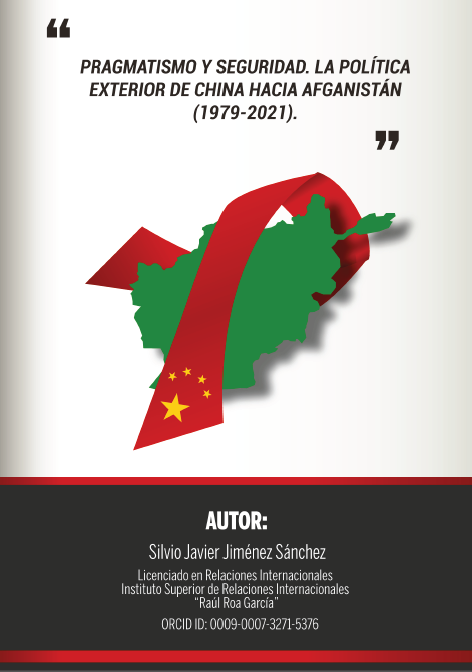Pragmatism and security. China's foreign policy towards Afghanistan (1971-2021)
Keywords:
China, Afghanistan, Taliban movement, securityAbstract
This article analyzes the evolution of China's foreign policy toward Afghanistan between 1979 and 2021, a period marked by prolonged armed conflict and the intervention of external actors. Chinese policy was characterized by a pragmatic and limited approach, prioritizing national and regional security, especially in relation to Xinjiang. During the Soviet-Afghan War, China supported the mujahideen to counter Soviet influence. Subsequently, in the face of the Afghan civil war and the rise of extremism, Beijing strengthened security cooperation with neighboring states, while maintaining discreet dialogue with the first Taliban Islamic Emirate to ensure stability on its border. Starting in 2012, with the withdrawal of Western troops, China increased its economic aid and military cooperation with the Islamic Republic, while maintaining communication with the Taliban. From an economic standpoint, although bilateral trade grew, large investment projects were hampered by the fragile security situation caused by the Afghan conflict. China also implemented a policy of strategic balance with the Afghan actors in conflict, which allowed it to mitigate the risks arising from Afghan instability and secure its security and economic interests.
Downloads
References
• Council of State. (2021). FM Meets with Afghan Taliban’s political chief. https://english.www.gov.cn/statecouncil/wangyi/202107/28/content_WS61011cfec6d0df57f98ddbb2.html
• De la Vega González, A. (2017). Factores de Continuidad y Cambio en la Organización de Cooperación de Shanghái en el período 2010-2016 [Trabajo de Diploma]. Instituto Superior de Relaciones Internacionales “Raúl Roa García”.
• Dillon, M. (2019). Xinjiang in the Twenty-First Century: Islam, Ethnicity and Resistance. Routledge.
• Donati, J. (2013, agosto 18). Missing refinery deal halts landmark China-Afghan oil project. Reuters. http://www.reuters.com/article/2013/08/18/afghanistanchina-idUSL4N0GJ05G20130818
• Encarnation, L., y Fair, C. C. (2024). China and the Taliban: Past as prologue? Journal of Strategic Studies, 47(5), 588–611. https://doi.org/10.1080/01402390.2023.2177988
•Shanghai Cooperation Organisation and Afghanistan: Interests and Limitations. Margalla Papers, 27(1), 82–95.
• Khan, J., y Sultana, R. (2019). Shanghai Cooperation Organization and Afghanistan: An Overview. 13(2).
• Ludwig, J. (2015). Sino-Afghan Relations in the Twenty-First Century: From Uncertainty to Engagement? Griffith Asia Quarterly, 3(1). http://hdl.handle.net/10072/340314
• Panda, J. P. (2021). Beijing’s Strategic Moments with Taliban: Policy, Strategy and Worldview. Manohar Parrikar Institute for Defence Studies and Analyses.
• Shanghai Cooperation Organisation. (2001a). Agreement on Regional Anti-Terrorist Structure between the Member States of the Shanghai Cooperation Organization. https://eng.sectsco.org/images/07e8/0c/14/1625858.pdf
• Shanghai Cooperation Organisation. (2001b). Charter of the Shanghai Cooperation Organization. https://eng.sectsco.org/images/07e8/0c/14/1625960.pdf
• Shanghai Cooperation Organisation. (2004). Agreement on Cooperation in Combating Illicit Traffic of Narcotic Drugs,Psychotropic Substances, and Precursors between the Member Statesof the Shanghai Cooperation Organization. https://eng.sectsco.org/images/07e8/0c/17/1627619.pdf
• Shanghai Cooperation Organisation. (2005a). Declaration by the Heads of the Member States of the Shanghai Cooperation Organization. https://eng.sectsco.org/images/07e8/0c/17/1626850.pdf
• Shanghai Cooperation Organisation. (2005b). Protocol on Establishment of SCO-Afghanistan Contact Group between Shanghai Cooperation Organisation and Islamic Republic of Afghanistan. Instituto de Relaciones Internacionales. https://www.iri.edu.ar/publicaciones_iri/anuario/CD%20Anuario%202006/Asia/grupo2.pdf
• Shanghai Cooperation Organisation. (2007). Joint communique Meeting of the Council of Heads of the Member States of the Shanghai Cooperation Organization. https://eng.sectsco.org/images/07e8/0c/17/1627974.pdf
• Shanghai Cooperation Organisation. (2009). Declaration of the Special Conference on Afghanistan Convened under the Auspices of the Shanghai Cooperation Organization (Moscow Declaration). UN Peacemaker. https://peacemaker.un.org/sites/default/files/document/files/2024/05/af090327moscowdeclaration.pdf
• Small, A. (2015, abril 27). From Bystander To Peacemaker: China, the Taliban, and reconciliation in Afghanistan. Berlin Policy Journal. https://berlinpolicyjournal.com/from-bystander-to-peacemaker/
• Umarov, A. (2017). Assessing China’s New Policy in Afghanistan. Central Asian Affairs, 4, 384–406. https://doi.org/10.1163/22142290-00404004
• United Nations Office on Drugs and Crime. (2009). Informe mundial sobre las drogas 2009. https://www.unodc.org/documents/wdr/WDR_2009/World_Drug_Report_2009_spanish.pdf
• Westcott, S. P. (2022). The Pragmatic Neighbour: China’s Afghanistan Policy 2001–2021. Journal of Asian Security and International Affairs, 9(3), 446–461. https://doi.org/10.1177/23477970221129909
• Zhao, H. (2012). China and Afghanistan: China’s Interests, Stances, and Perspectives. Center for Strategic and International Studies. https://ciaotest.cc.columbia.edu/wps/csis/0024849/f_0024849_20320.pdf
• Zhou, J., Su, F., y Yuan, J. (2022). Treading Lightly: China’s Footprint in a Taliban-led Afghanistan. SIPRI Insights on Peace and Security. 6 https://www.sipri.org/sites/default/files/202211/sipriinsights_2208_china_and_afghanistan_2.pdf

Downloads
Published
How to Cite
Issue
Section
License
Copyright (c) 2025 Ad Hoc

This work is licensed under a Creative Commons Attribution-NonCommercial 4.0 International License.











